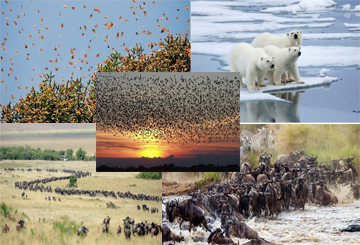
Aisha Naz
Climate journalist
Climate change makes animal immigrants in search of survival
As the impacts of climate change continue to intensify, an increasing number of species are being forced to leave their traditional habitats and move to new areas in search of food, shelter, and suitable climates. This unprecedented migration, much like the movement of human immigrants, is reshaping ecosystems and altering the balance of biodiversity worldwide.
Changing Habitats: the New Reality for Wildlife. In the face of rising temperatures, changing rainfall patterns, and extreme weather events, many animal species are being pushed to find new homes. These “climate refugees” are no longer confined to the areas where they have historically thrived, and they are finding new territories across the globe. While human migration due to climate change is often a topic of heated political debate, the movement of animals is becoming an equally pressing issue.
One of the most notable examples of climate-driven animal migration is the plight of the polar bear. As the Arctic ice melts due to rising global temperatures, these iconic creatures are losing their primary habitat: the sea ice they rely on for hunting seals. With the ice thinning and breaking up earlier in the year, polar bears are increasingly venturing into human settlements in search of food. This new “immigration” into populated areas leads to conflicts with humans and threatens the survival of the species.
As the ice melts further, polar bears are being forced to travel greater distances and move closer to the mainland, which may not offer the same resources they need to thrive. These animals, once native to the frozen expanse of the Arctic, are now facing a new and uncertain future, navigating the borders of their traditional environments.
The Case of Birds and Insect Migration
Birds, too, are adjusting to the shifting climate. Some species that typically migrate across long distances are altering their routes or migrating at different times of the year. For instance, many birds in the Northern Hemisphere are arriving earlier in the spring due to warmer temperatures, while some species are now wintering further north than ever before.
Similarly, insects like the monarch butterfly have also been observed altering their migration patterns. Traditionally traveling from North America to Mexico, monarchs are now being found in locations further north, where mild winters had previously been rare. In some cases, insects are also facing the risk of being stranded in unfamiliar areas without the appropriate seasonal cues to guide their migration.
While climate change is forcing animals to relocate, these new territories present challenges of their own. Many species are encountering ecosystems that are already occupied by other animals, resulting in competition for resources. Invasive species are also on the move, often outpacing native species in the race to adapt to changing conditions.
The shifting migration patterns of animals are creating imbalances in local ecosystems, and many species may not survive the migration to new areas. The species that are able to adapt will have to learn to thrive in foreign environments, which may be drastically different from the ones they were originally adapted to.
Experts warn that without concerted efforts to mitigate climate change, the situation will continue to worsen. Reducing carbon emissions, protecting wildlife corridors, and creating more sustainable habitats are just some of the measures that can help ensure the survival of species that are migrating due to climate change
“Climate change is not just a human issue,It is a global crisis that is affecting every living being on Earth, and we must work together to protect these animals who are being forced to leave their homes in search of survival.”
As the world comes to terms with the realities of climate change, it is becoming clear that animals, too, are facing the struggles of immigration and displacement. The urgent need for global action is now more apparent than ever as we confront the consequences of a changing climate on both humans and wildlife alike.


